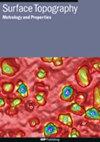混合润滑滑动磨损过程中斜齿轮齿面形貌和摩擦学特性的演变
IF 2
3区 材料科学
Q2 ENGINEERING, MECHANICAL
引用次数: 0
摘要
在混合润滑中,齿面之间的润滑剂流动、固体表面接触和材料磨损的相互作用会在齿面上产生复杂且不可预测的接触状态。为全面了解斜齿轮粗糙齿面的润滑和磨损特性之间的相互作用,本研究基于混合弹流体动力学润滑模型和 Archard 模型,建立了斜齿轮混合润滑滑动磨损计算模型。具体而言,研究旨在考察表面形貌特征对平均油膜厚度、接触面积比和啮合点累积磨损的影响。研究结果表明,非高斯重建表面的纹理和功率谱密度分布与实际地面的纹理和功率谱密度分布非常相似。此外,对于非高斯粗糙表面,较大的波长比会增强微边运动,从而增加薄膜厚度并减少磨损。此外,与正偏斜表面和高斯表面相比,负偏斜表面的润滑性能更好。负偏斜表面的接触面积比更小,累计磨损值更低,这就证明了其润滑性能的提高。本文章由计算机程序翻译,如有差异,请以英文原文为准。
Evolution of tooth surface morphology and tribological properties of helical gears during mixed lubrication sliding wear
In mixed lubrication, the interplay of lubricant flows, solid asperity contact, and material wear between tooth surfaces creates complex and unpredictable contact states on tooth surface. To comprehensively understand the interaction between the lubrication and wear characteristics of the rough tooth surfaces of helical gears, this study established a mixed lubrication sliding wear calculation model for helical gears based on the mixed elastohydrodynamic lubrication model and Archard’s model. Specifically, the study aimed to examine the effects of surface topography features on average film thickness, contact area ratio, and accumulated wear at the meshing point. The findings demonstrated that the texture and power spectral density distributions of a non-Gaussian reconstructed surface closely resembled those of the actual ground surface. Furthermore, for non-Gaussian rough surfaces, a larger wavelength ratio enhanced microwedge motion, which increased film thickness and reduced wear. Additionally, a negatively skewed surface demonstrated better lubrication performance compared to both positively skewed and Gaussian surfaces. This improved performance is evident in the smaller contact area ratio and lower accumulated wear value of the negatively skewed surface.
求助全文
通过发布文献求助,成功后即可免费获取论文全文。
去求助
来源期刊

Surface Topography: Metrology and Properties
Materials Science-Materials Chemistry
CiteScore
4.10
自引率
22.20%
发文量
183
期刊介绍:
An international forum for academics, industrialists and engineers to publish the latest research in surface topography measurement and characterisation, instrumentation development and the properties of surfaces.
 求助内容:
求助内容: 应助结果提醒方式:
应助结果提醒方式:


